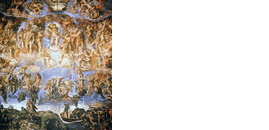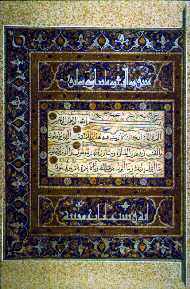
|
|
|
|
|
Class
Prep
|
|
|
|
- Apocalyptic
Features of the Qur'an
-

- There is not apocalypse in the Qur'an anything like what we saw in 1 Enoch, the Book of Daniel, or the Book of Revelation. Nevertheless, certain features of apocalyptic that we have found in the Jewish and Christian tradition are present in the Qur'an, given Muhammad's exposure to Judaism and Christianity and his self-concious belief that the Qur'an represents the same message given to Abraham, Moses and Jesus.
-
- The reading selections for today begin first with three surahs or chapters from the Qur'an, the first (Al Fatihah, or the Opening), surah 57, and surah 75. As you read these, note on a piece of paper every phrase that appears apocalyptic, and identify the feature it seems to represent (ethical dualism, two worlds/ages). Also, please fill in the handout, "Some Theoretical Frameworks for Approaching Apocalyptic Thought, Movements and Groups." As we review the early history of Islam in class on Wednesday, we will see which of these theoretical frameworks might be most helpful in understanding the apocalyptic elements in the Qur'an.
-
- The Amanat article begins to take us in the direction of our final topic, apocalypticism in contemporary Islam. But whereas our readings on the Monday after Thanksgiving will focus on 9/11 and its aftermath, Amanat's article will provide a longer view, insofar as he looks at movements within Sunni and Shi'a Islam and the Baha'i Faith in the last two centuries. As you read Amanat, consider the following issues and questions:
-
-
- Amanat argues that apocalypticism has become a strategy to transform normative Islam since the Qur'an. Explain what he means.
- What are some of the characteristics of Sunni frontier messianism? Be able to provide one historical example.
- Explain the Shi'a belief in the mahdi: its origins in the line of succession from the prophet, his role in the end time, and the term "occultation." Define the term dajjal.
- How does the Baha'i faith diverge from the Sunni and Shi'i tradition on the notion of the hidden Imam?
- How are apocalyptic beliefs adapted in the Ahmadiyya sect (considered heretical by Sunnis and Shi'ites)?
-
-
- Assigned Readings
- Primary: Quran, surahs 1; 57; 75;
Yusuf 'Ali's translation is available online
- Secondary: Amanat, "The Resurgence of Apocalyptic
in Modern Islam" (ERes)
- Optional: Al
Qiyama.org (browse web site)
Optional Draft of Research Paper Due
-
-
- Further Reading
-
- See also the section of the Course Bibliography on Classical
Islamic Apocalypticism.
-
-
- Links
-
-
-
- Sources
- Photograph: "Page from a Koran, Egypt, 14th Century, Arthur M. Sackler Gallery," slide S86.0066, Arthur M. Sackler Gallery, Washington, D.C.
|
|
|
|
|
